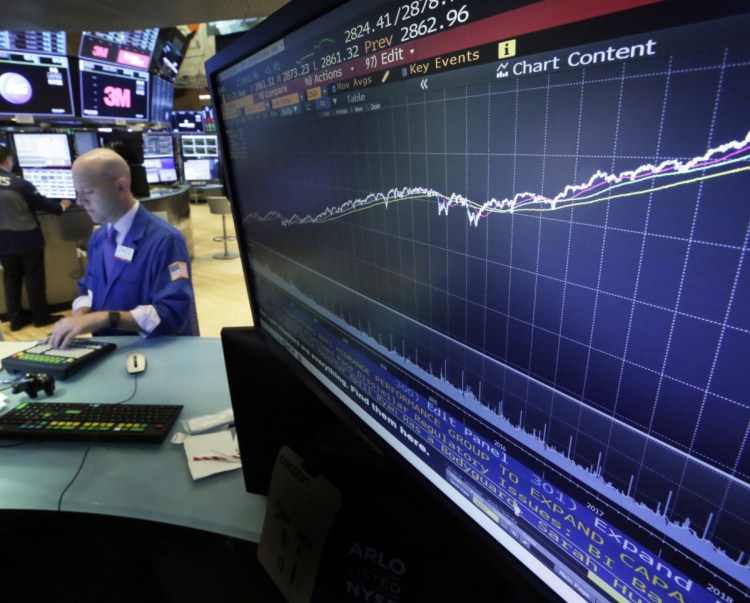The bull market in U.S. stocks is now the longest on record.
The current bull run on Wall Street became the longest in history on Wednesday at 3,453 days, beating the bull market of the 1990s that ended in the dot-com collapse in 2000.
That’s how long the benchmark S&P 500 index of major U.S. stocks has gone without a drop of 20 percent or more, the traditional definition of a bear market.
Despite its long duration, this bull market actually wasn’t as big in terms of overall gains as the 1990s one.
The milestone arrived on a listless day of trading that left the S&P 500 with a slight loss. Gains by technology and energy companies outweighed losses in industrial stocks, banks and other sectors.
“This expansion is alive and well, this bull market is alive and well,” said Jason Pride, chief investment officer for private clients at Glenmede. “Valuations are definitely higher than we tend to like to see them, but they’re actually not that atypical for the back part of an economic expansion.”
The S&P 500 index finished with a loss of 1.14 points, or 0.04 percent, at 2,861.82. The Dow Jones Industrial Average slid 88.69 points, or 0.3 percent, to 25,733.60. The Nasdaq composite gained 29.92 points, or 0.4 percent, to 7,889.10.
The Russell 2000 index of smaller-company stocks picked up 4.50 points, or 0.3 percent, to 1,722.54. The Russell marked its second straight all-time high.
Gainers finished with a slight edge on decliners on the New York Stock Exchange.
LAGGING OTHERS IN MAGNITUDE
The bull market for U.S. stocks began in March 2009 and has now lasted nine years, five months and 13 days, a record that few would have predicted when the market struggled to find its footing after a 50 percent plunge during the financial crisis.
The long rally has added trillions of dollars to household wealth, helping the economy, and stands as a testament to the ability of large U.S. companies to squeeze out profits in tough times and confidence among investors as they shrugged off repeated crises and kept buying.
Despite its longevity, the bull market lags others on the basis of magnitude, or the cumulative gain it has generated for investors.
As of Tuesday, the S&P 500 had climbed 323 percent over the current bull market. By comparison, the bull market that ran through much of the 1990s and ended in March 2000 led to a 417 percent gain for the S&P 500, according to S&P Dow Jones Indices.
“While it’s long in time, it could still go on longer because, magnitude-wise, it’s just not that far (along),” Pride said.
Despite the milestone, investors mainly kept an eye on company earnings reports and the release of the minutes from the Federal Reserve’s most recent meeting of policymakers earlier this month.
The minutes of their discussions revealed deepening concerns that escalating trade wars could hurt the economy. The minutes also underscored expectations that the central bank is likely to increase its policy rate at its next meeting in September.
The afternoon release of the minutes didn’t have much of an impact on the market, which continued to trade in a narrow range.
TRADING IN NARROW RANGE
Later this week, central bankers, including new Fed chief Jerome Powell, gather in Jackson Hole, Wyoming, an annual symposium that has often generated market-moving news.
Stocks traded mostly in a narrow range for much of the day Wednesday.
Technology sector stocks reversed course after an early slide. Nvidia gained 3.8 percent to $262.82.
Traders also bid up shares in a couple of big retailers that reported quarterly results that topped Wall Street’s expectations. Target climbed 3.2 percent to $85.94, while Lowe’s jumped 5.8 percent to $105.52.
Industrial stocks took some of the heaviest losses. American Airlines Group lost 2.8 percent to $39.19.
U.S. benchmark crude climbed 3.1 percent to $67.87 per barrel in New York. Brent crude, the standard for international oil prices, dipped 0.1 percent to $74.70 per barrel in London.
The pickup in oil prices helped boost energy sector stocks. Marathon Oil gained 3.3 percent to $20.87.
In other energy futures trading, heating oil rose 2.1 percent to $2.17 a gallon. Wholesale gasoline gained 2.5 percent to $2.07 a gallon. Natural gas dropped 0.8 percent to $2.96 per 1,000 cubic feet.
Bond prices rose. The yield on the 10-year Treasury fell to 2.82 percent from 2.84 percent late Tuesday.
Copy the Story LinkSend questions/comments to the editors.



Success. Please wait for the page to reload. If the page does not reload within 5 seconds, please refresh the page.
Enter your email and password to access comments.
Hi, to comment on stories you must . This profile is in addition to your subscription and website login.
Already have a commenting profile? .
Invalid username/password.
Please check your email to confirm and complete your registration.
Only subscribers are eligible to post comments. Please subscribe or login first for digital access. Here’s why.
Use the form below to reset your password. When you've submitted your account email, we will send an email with a reset code.